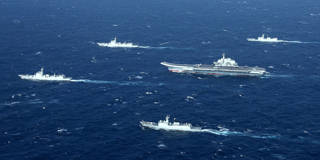With the wars in Ukraine and Gaza stretching its military resources thin, a direct confrontation with China is the last thing the US needs. But America’s refusal to rein in China's aggressive expansionism, not least in the South China Sea, may well make a clash more likely – and more destructive.
HANOI – For over a decade now, China has been working stealthily to alter the territorial and maritime status quo in the Indo-Pacific – an effort that has increasingly stoked tensions with regional neighbors like Australia, India, Japan, Taiwan, and several Southeast Asian countries, as well as the United States. And with US attention and resources focused on conflicts in Europe and the Middle East, China has lately become even more aggressive in its expansionism. Chinese regional hegemony is closer than ever.
Almost daily, China finds a new way to bully Taiwan, which Chinese President Xi Jinping has repeatedly pledged to “reunify” with the mainland (though that objective has no basis in international law or history). As China takes steps like encroaching on Taiwan’s air-defense zone and encircling the island with warships, it raises the risk of a war that would transform global geopolitics.
There are war clouds also gathering over the Himalayas, where a military standoff triggered by China’s repeated furtive encroachments on India’s borderlands has dragged on for nearly four years. And in the East China Sea, China’s intrusions into the territorial waters and airspace of the Japanese-controlled Senkaku Islands, which China claims as its own, are fueling Japan’s drive toward rearmament.

HANOI – For over a decade now, China has been working stealthily to alter the territorial and maritime status quo in the Indo-Pacific – an effort that has increasingly stoked tensions with regional neighbors like Australia, India, Japan, Taiwan, and several Southeast Asian countries, as well as the United States. And with US attention and resources focused on conflicts in Europe and the Middle East, China has lately become even more aggressive in its expansionism. Chinese regional hegemony is closer than ever.
Almost daily, China finds a new way to bully Taiwan, which Chinese President Xi Jinping has repeatedly pledged to “reunify” with the mainland (though that objective has no basis in international law or history). As China takes steps like encroaching on Taiwan’s air-defense zone and encircling the island with warships, it raises the risk of a war that would transform global geopolitics.
There are war clouds also gathering over the Himalayas, where a military standoff triggered by China’s repeated furtive encroachments on India’s borderlands has dragged on for nearly four years. And in the East China Sea, China’s intrusions into the territorial waters and airspace of the Japanese-controlled Senkaku Islands, which China claims as its own, are fueling Japan’s drive toward rearmament.